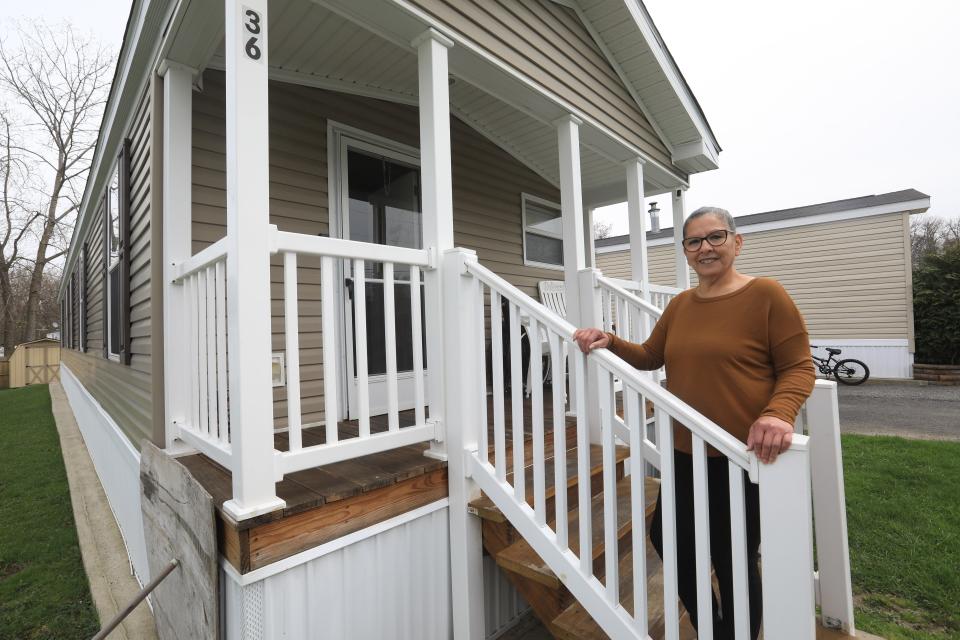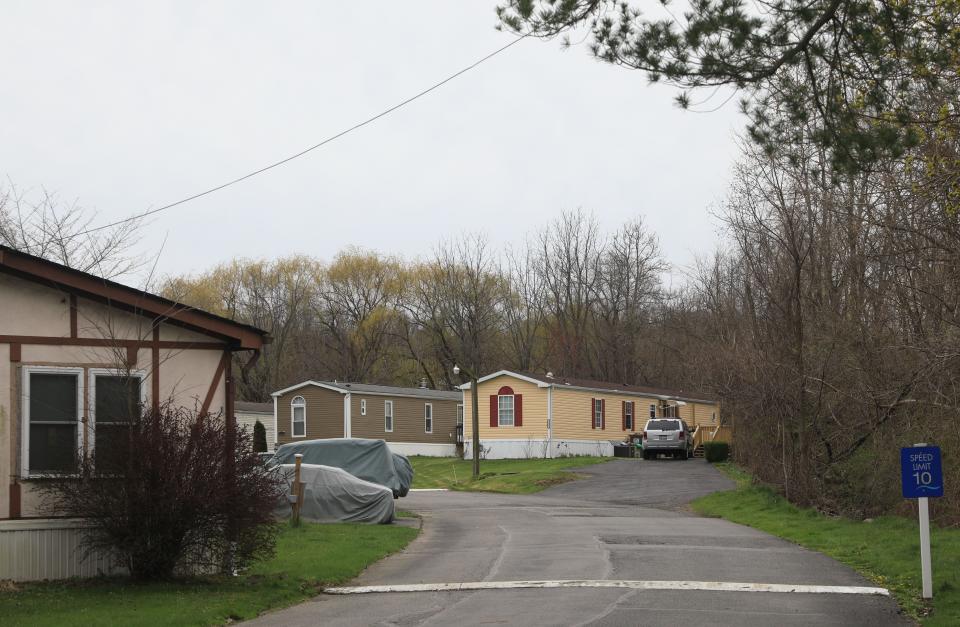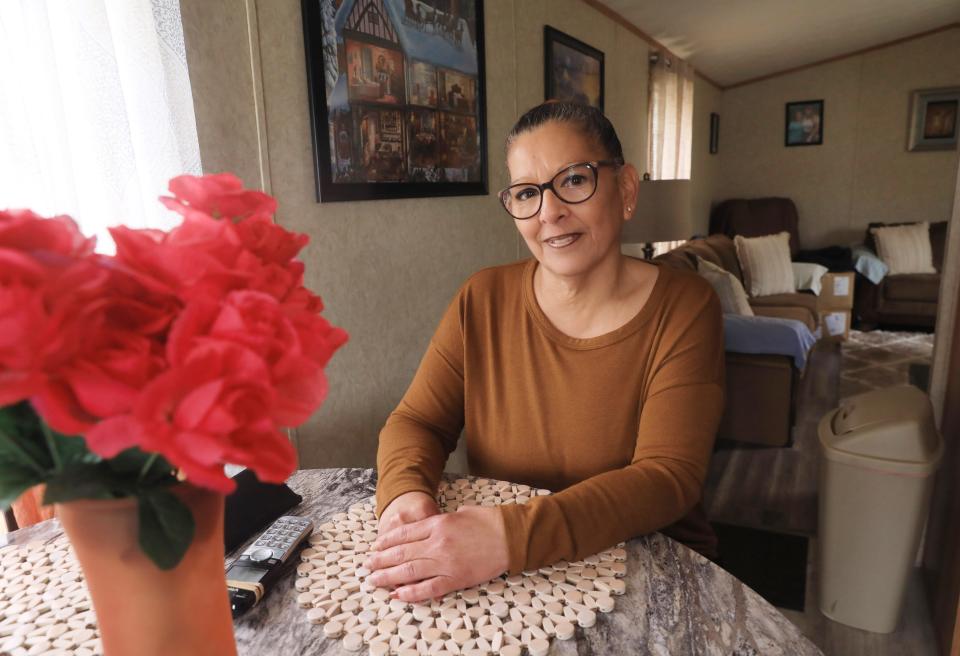Unable to get a mortgage, millions of Americans turn to risky lenders, but at what cost?
When Yvonne Maldonado bought her New York mobile home, she thought she had found a cost-efficient place where she could live out her golden years.
But the deal soon soured after the purchase of the three-bedroom home in the Silver Stream Village Manufactured Home Community in New Windsor, a small town about 60 miles north of New York City.
Maldonado, 63, was already locked into a nearly 9% personal property loan when a new landowner sought to raise rents on the land where her home sits. At the time, finances were tight because her adult son had moved out, and she was not working.
Maldonado is far from the first homeowner to secure a riskier home loan.
At least 1 in 5 Americans borrowers turned to alternative financing at least once in their lifetime, embracing high-cost home loans with often unfavorable terms, according to a new report by non-profit think tank The Pew Charitable Trusts. And experts worry many more low-wage workers have embraced risky lenders and non-traditional home loans during the rush in recent years to purchase property, a worrisome trend that could result in mass foreclosures and plummeting neighborhood property values.
"Alternative financing is pitched as another pathway to homeownership when mortgages are not available, but the reality is many alternative financing borrowers never achieve their goal of owning," said Tara Roche, manager of The Pew Charitable Trusts’ home financing project.

►Do you really need a real estate agent?: How this homebuyer got her own housing market lead
Non-traditional loans create risks
Traditional mortgages remain the gold standard for financing home purchases because of their protections that make crystal clear the rights, responsibilities and benefits of homeownership, Roche said. In contrast, alternative finance agreements often have higher interest rates and higher monthly payments and lack consumer protections that can protect against eviction or foreclosures.
A shortage of mortgages for properties less than $150,000 may be driving the demand, along with factors such as low credit scores that have penalized prospective home buyers, the Pew report said.
.oembed-frame {width:100%;height:100%;margin:0;border:0;}
►In a hot housing market: Startups offer all cash to help home buyers, but some are skeptical
Hispanic borrowers such as Maldonado were most likely to use the alternative financial agreements, the survey found. Black Americans were the second most likely demographic to sign up for non-traditional financing.
“I mean a lot of times I wonder, ‘Wow, am I really going to make it to pay this loan,’” said Maldonado, who now works as an organizer with manufactured home nonprofit MHAction. When you add it up, she said, most of the roughly $2,000 she pays out in monthly home expenses isn't going toward paying off the principal on the personal property loan for the mobile home.
Popular alternative housing agreements include:
Lease-to-purchase arrangements, where the seller is the landlord and the buyer lives in the house as a tenant after typically paying an upfront fee in exchange for the option to purchase the home. Housing attorneys say the homes are often in bad condition and rely on the tenants completing thousands of dollars in repairs to make the space habitable. The tenant can lose out on the upgrades and be evicted should they get behind or dispute at least one payment.
Land contracts, where the seller of the property extends credit directly to the buyer without the involvement of a third-party lender such as a bank or credit union. The buyer then pays regular payments on the debt, with some portion of it going toward purchasing the home. The seller keeps full legal ownership of the property until the final payment, meaning the buyer can be easily evicted.
Personal property loans, where buyers purchase manufactured homes, also called mobile homes, through subsidiary lenders, manufactured home builders and others, the Pew report said. Compared with traditional mortgages, the loans have higher interest rates and shorter terms, leading to higher monthly payments. Homes covered in this agreement can be quickly repossessed and aren’t subject to a traditional foreclosure process.
Seller-financed mortgages, where the buyer purchases the home with credit extended by the seller. The home's deed is transferred to the buyer at the start of the agreement, giving the new occupant full ownership rights as the credit is being paid. However, this agreement does not give the buyers recourse should there be competing claims for the title.
Personal property loans are the most common form of alternative financing, according to Pew.
They are also one of the riskiest types of non-traditional loans.
About 70% of people who use personal property loans rent the land where their homes sit, raising the possibility of being evicted because of sharp rent increases, the report stated.
.oembed-frame {width:100%;height:100%;margin:0;border:0;}
Maldonado knows this well. She and other people in her mobile home were able to fight off a nearly 5% rent increase in 2019 but Maldonado fears more rent hikes are looming.
In the end, RHP Properties, the company that owns the land, settled on a 3% annual rent increase, according to Glenn Oswald, a company spokesperson. The company declined to answer further questions about how rent increases could affect clients that purchased homes with alternative financing.
Between her mortgage and lot rent, Maldonado pays more than $1,500 each month on the mobile home that cost $54,000 when she purchased it.
“The rents are really overpriced," Maldonado said, especially for families that have a personal property loan.
She added: “In these communities, you have seniors, you have veterans, low-income families, immigrant families — people that just want to make a decent living and own their home.”

Millions use alternative financing
Roughly 1 in 15 current home borrowers – around 7 million Americans – are currently using alternative home financing, the report found. Buyers with household incomes below $50,000 were more likely to turn to unconventional borrowing.
Sarah Bolling Mancini, staff attorney at the National Consumer Law Center, said the use of alternative home financing grew before the pandemic and it's likely many more people whose credit took a dive because of the pandemic and resulting economic fallout might have turned to these alternatives in greater numbers.
Many consumer advocates are waiting to see if there will be another foreclosure crisis if buyers are unable to pay off mortgage payments delayed because of pandemic protections, Mancini said. That also could result in many more Americans being shut out of traditional mortgage loans, leading to more people turning to alternative housing agreements.
The National Association of Realtors found Latinx families experienced the largest homeownership gains throughout the pandemic at 51%. In the same period, homeownership only rose by 1.4 percentage points for Black families.
‘They're expected to fail’
Homeownership has long been viewed as a vehicle of wealth accumulation and economic stability for American families.
Yet for many people of color, homeownership remains out of reach due to decades of disinvestments and racist practices such as redlining, where banks and financial institutions limited loans, mortgages and insurance in specific geographic areas based on color and ethnicity.
"The three Cs that determine mortgage access—credit, collateral and capacity—reflect and perpetuate a long history of racial discrimination in U.S. public and private institutions," said Janneke Ratcliffe, vice president of the Urban Institute Housing Finance Policy Center in Washington, D.C.
The result is that the gap in homeownership rates between Black and white families is bigger today than when segregation was legal, according to a study by the Urban Institute. About 71% of white Americans own homes, compared with 41% of Black Americans.
In recent decades, the disparity was fueled in part by the housing bubble and subsequent bust of the 2000s. At the time, not only did Black homebuyers purchase more expensive homes at the height of the market, but they also disproportionately held subprime mortgages with higher rates. As the foreclosure crisis ravaged towns and cities, many Black families lost their only source of equity: their homes.
Many lenders responded to the housing crisis by making it more difficult to acquire a mortgage loan, such as by raising the credit scores needed to qualify. Such policies disproportionately hurt Black and Latino families, who tend to have far less wealth than white families.
"The extreme tightening of the credit box that occurred after the Great Recession has not fully eased, making it very difficult for many households with lower scores to qualify for mortgages," said Ratcliffe, of the Urban Institute Housing Finance Policy Center.
Black and Latino borrowers were already more likely to have their mortgage applications denied. When they are approved, they are more likely to receive high-cost mortgages.
But while more Black sand Latinos have turned to risky lenders as a solution, such forms of financing are not designed to build equity for homeowners, said Chris Herbert, managing director of the Joint Center for Housing Studies at Harvard University in Cambridge, Massachusetts.
Instead, they're designed to strip equity by charging very high-interest rates and setting up other terms that make it hard for people to follow through on paying off the contract, Herbert said.
Atlanta Legal Aid Society lawyer Jennifer Rentenbach said many rent-to-own agreements and seller contracts agreements are legally questionable. And if a tenant were to miss one payment, she said, they could lose the money they invested, the option to buy the home or be evicted.
“They're expected to fail because a lot of people out there, I think, are making their money off of churning these arrangements,” Rentenbach said.
Her advice is simple: “Just don’t do it.”
“It takes longer and harder to get into homeownership, but try to just work on your credit and try to save money and go the traditional way with a regular mortgage through a bank or credit union,” she said.
Affordable homes, but tough to finance
Part of the problem is that banks have little desire to finance small mortgages, said Herbert of Harvard University. Financial institutions earn money by charging fees and a percentage of the mortgage, so the amount of the loan impacts their bottom line.
Dave Anderson, executive director of the National Manufactured Home Owners Association, said mobile homes remain affordable because they have a simple design.
Yet banks, he said, are often reluctant to provide mortgages to purchase manufactured homes because of their low cost compared with traditional properties.
“Banks may be looking at that and thinking, ‘Are we going to make anything on this? Are we just providing a public service to provide loans?’”Anderson said.
For many buyers, the benefits of buying a cheap home are clear.
Natividad Seefeld, 61, lives in a tight-knit mobile home community in Fridley, Minnesota, where camaraderie abounds and rent increases are few and far in between. In 2011, residents of the Park Plaza neighborhood were able to buy the community from the owner and transformed it into a non-profit co-op.
But Seefeld, president of the cooperative, remembers the stress of trying to finance her mobile home as a newly single parent with four children in the late 1990s.
Seefeld ultimately took out a high-interest loan, which was repeatedly bought and sold to the point that Seefeld felt that she would never pay "my house off.”
“I just felt like I was digging deep into the ground with this mortgage because of the interest rate alone and I wasn't making a lot of money,” Seefeld said. “Our rent wasn't very high but I still couldn't live on my own.”

When she tried to refinance, both her bank and then a credit union told her they didn't do manufactured housing. Eventually, she was able to pay the loan off after filing for bankruptcy. These days, she pays $528 a month in rent on her mobile home built in 1979 and advocates for mobile homes to remain affordable options for people looking to own their homes without being in overwhelming debt.
“Say I’m buying a used (mobile) home for $20,000 or something, why can’t I get the same loan the next person got?” she inquired. “I want it to be the same.”
Follow USA TODAY national correspondents @T_Cusaac and @RominaAdi on Twitter.
This article originally appeared on USA TODAY: Some home loan lenders put people at risk. How's your mortgage compare

